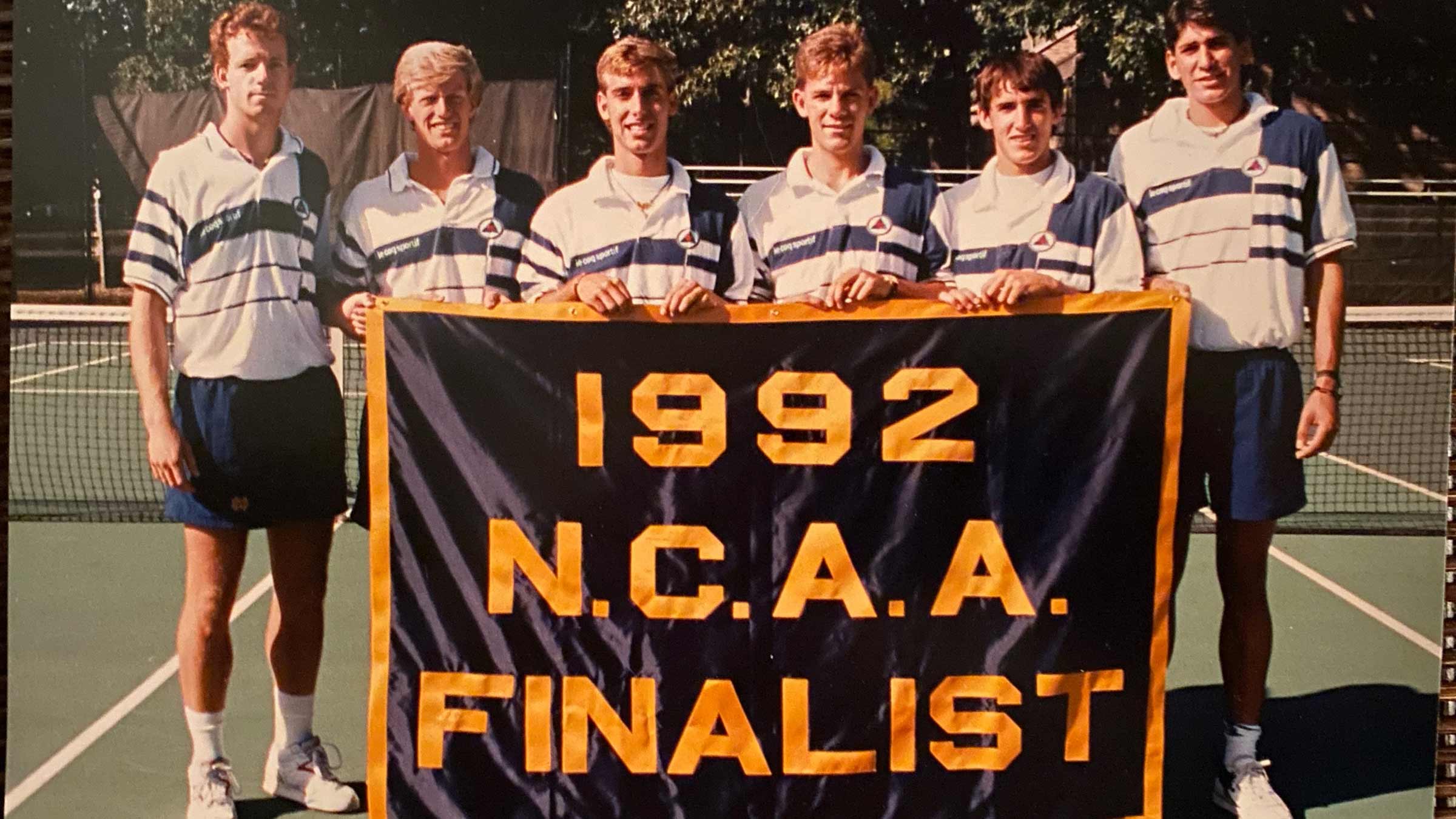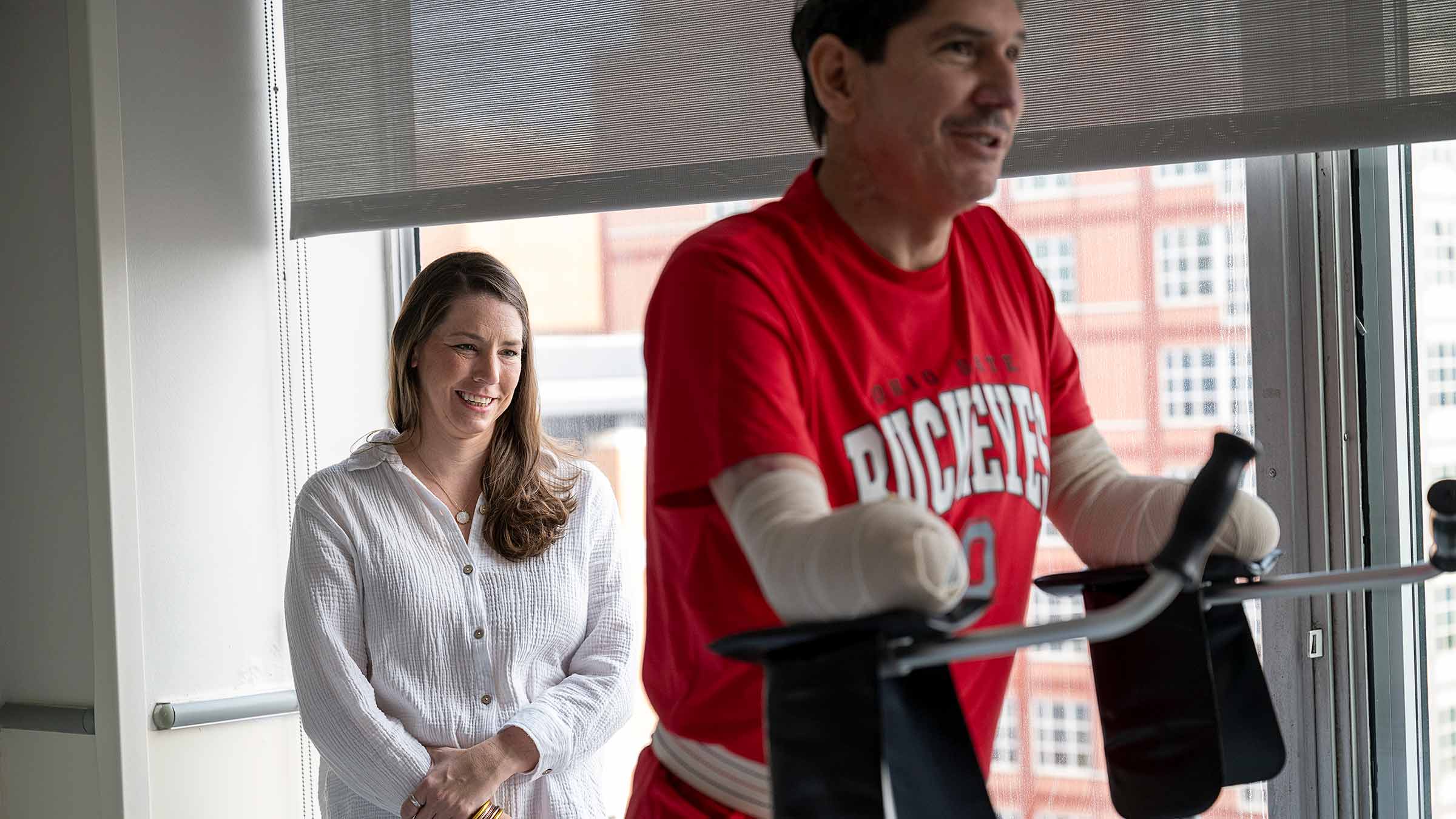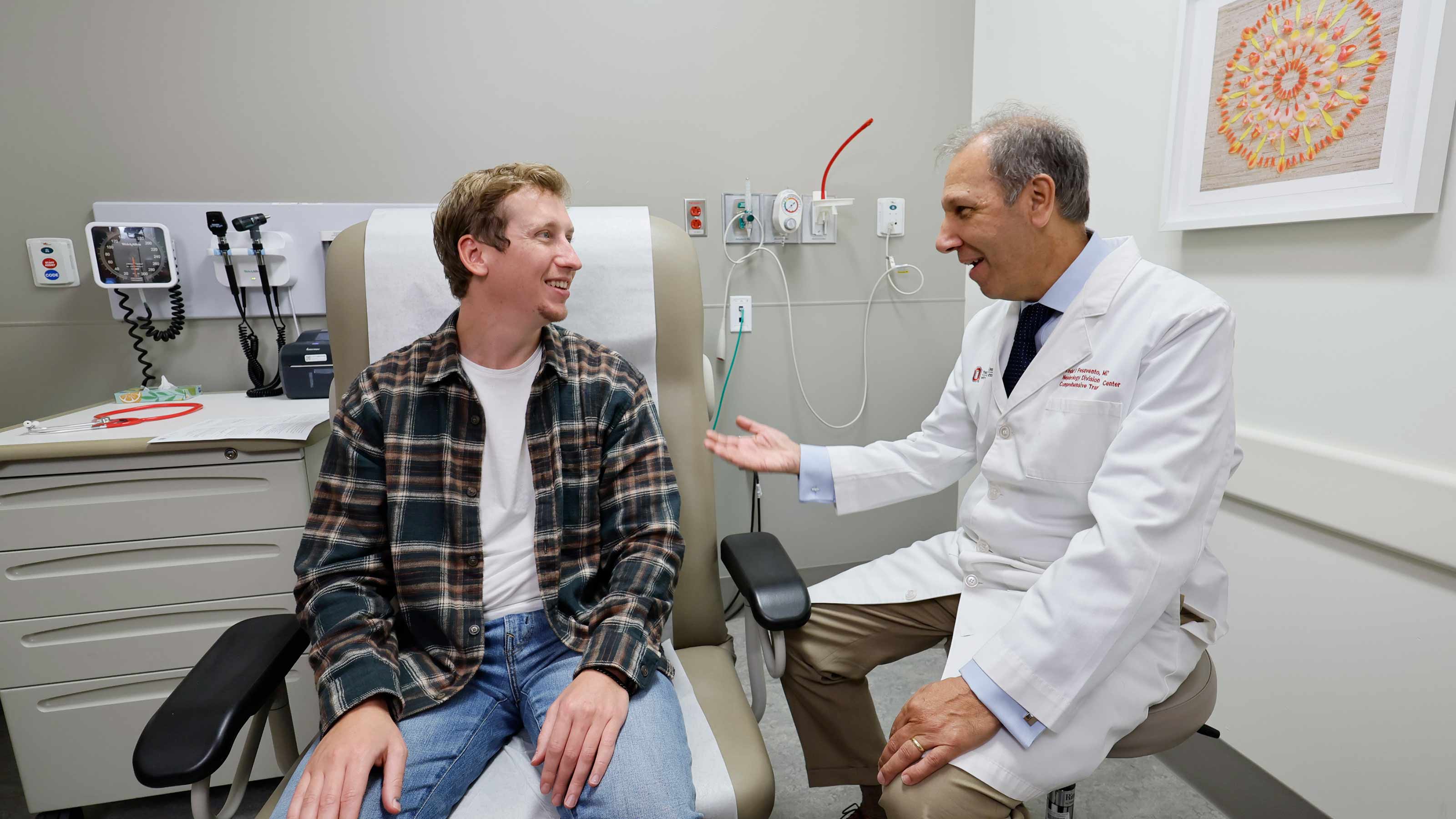
Facing quadruple amputation, Texas man finds hope in Ohio State surgical team
Specialized plastic and reconstruction surgery experts help former tennis star who dreams of returning to the court
The reality was harsh. Ron Rosas was leaving his family and friends in Dallas, Texas, with his legs and arms intact for the last time. Pneumonia that turned septic had ravaged his body, turning parts of his feet, knees, arms and nose black. His sepsis had caused necrosis, a condition in which cells and tissue die due to lack of blood supply. He was headed to The Ohio State University Wexner Medical Center to have all four limbs amputated. As he glanced out the small oval airplane window,  he felt something stir that he hadn’t felt for weeks — hope and, strangely, excitement.
he felt something stir that he hadn’t felt for weeks — hope and, strangely, excitement.
“I knew my limbs were useless and once I wrapped my head around it, I said ‘Let’s move forward. I’m all in.’ I don’t know if you’ve ever heard of anyone feeling excited about a surgery, let alone this type of surgery, but I was finally going to get some relief and knew I was going to be in good hands with Dr. Jason Souza and his team at Ohio State,” the 52-year-old says.
Former tennis star faces quadruple amputation
Rosas’ journey to Ohio started when his in-laws, desperate to find the best surgical team for their son-in-law, scoured the internet looking at advanced amputation programs. Their search led them to Ohio State’s one-of-a-kind Military Medicine Program, led by Jason Souza, MD, a clinical associate professor of Plastic and Reconstructive Surgery in the Ohio State College of Medicine. Rosas was determined to save the elbow in his dominant right arm so he could play tennis again. A star tennis player, in 1992 he was part of the University of Notre Dame team that rose from lowest ranked in the NCAA Men’s Tennis Championship to the title match. Once again, Rosas was focused on beating the odds and playing the sport that he’d loved since age 7.

“Can’t be done,” Rosas was told over and over again about saving his right elbow. That mantra changed when he met virtually with Dr. Souza and learned about his extensive experience in restoring and reconstructing injured limbs. Dr. Souza promised that not only could Rosas’ elbows be saved and more of his legs preserved, but he could circumvent the debilitating phantom limb pain that often plagues amputees.
“Hearing their expertise and having the entire team on the call really gave us not only hope but comfort,” says Rosas’ wife, Victoria.
Hope and comfort were exactly what the family needed after nearly losing Ron. His illness started with a case of shivers during the night of Dec. 29, 2022. His COVID-19, flu and strep tests came back negative, but his symptoms kept getting worse. He was dizzy, disoriented, antsy. When his pulse oximeter dipped to 62%, Victoria knew something was terribly wrong. She called an ambulance and a couple of hours later he was moved from the ED in a Dallas hospital to intensive care where he was immediately intubated. It wasn’t long afterward that last rites were administered.
“I honestly didn’t think he was going to make it,” Victoria says. Rosas had gone into respiratory failure and, to save his life, he was put on extracorporeal membrane oxygenation (ECMO), a type of artificial life support that eases the strain on the lungs and heart. He was on ECMO for 12 days and, while it saved his life, it resulted in poor blood flow to his limbs. At first, he was told he might lose some toes or fingers, but then more and more skin kept turning black and it became evident that he was going to lose a significant portion of all limbs.

Finding hope 1,000 miles away with Ohio State’s plastic and reconstruction surgery experts
“Ron and his family were coming to terms with the idea that his limbs may not be salvageable because of so much damaged tissue. Many places look at amputation as a purely ablative surgery, which has a main purpose of taking things away. At Ohio State, we take a radically different approach. We try to see amputation as a functionally reconstructive surgery. We then apply all of the surgical sophistication necessary to optimize function and minimize pain despite the loss of the distal limb,” Dr. Souza says.
Ron and Victoria traveled more than 1,000 miles to the Ohio State Wexner Medical Center, leaving behind their four children, the youngest just 6 years old.
While the surgery wasn’t an easy decision, it was the right one, Victoria says. Dr. Souza called her at 2:30 a.m. after the first major surgery, which took 15 hours, to discuss it and reassure her that everything was going as planned.

Rosas began to see small signs of hope, like when the night sweats he’d been experiencing in Texas abruptly stopped. Helping him cope with the mental stress of losing all his limbs was psychologist Chelsea Kane, PsyD, clinical assistant professor of Physical Medicine and Rehabilitation in the Ohio State College of Medicine.
“Dr. Kane was introduced to me from the beginning, and her approach was empathy, comfort and strength, building for what I was about to encounter. Every step of the way, with all the doctors, caretakers, nurses, techs, ICU students, Destination Medicine and so many others, was so much care and empathy,” Rosas says.
The Buckeye team rallies around their patient
During Rosas’ nearly five-week-long stay in Columbus, more than 100 staffers were involved in his care following a series of complex surgeries that included transferring large portions of skin and fat from various parts of his thighs and trunk to all four limbs, adding small muscles to his right arm to serve as control signals for his future prosthetic arm and rewiring the nerves of his limbs to prevent phantom pain. In all, Rosas underwent almost 70 hours of surgery.
During these long microsurgical procedures, the nursing team entertained his 6-year-old daughter, Vivienne, by decorating an Easter basket for her, roaming the hospital with her in search of Brutus Buckeye images and bringing in Hudson, a Buckeye Paws therapy dog who also comforted Rosas by lying next to his bed after a long surgery.

“That’s her dad and she’s only 6 and there’s so much fear for him. Everyone gave her a bunch of love,” says Tova Myers, CNML, nurse manager of the hospital’s ninth floor where Rosas received care. “Ron was also a partner in his own care, and everyone enjoyed spending one-on-one time with him and being part of ‘Team Ron.’ The connection and bond he made with the staff was amazing.”
Physical therapist Maggie McCool, DPT, PT, and occupational therapist McKenzie Stevens became close to Rosas and his family, visiting them when the two were in Texas for a conference and marveling at his progress in walking with prosthetic legs.
Becoming a Buckeye
“Ron, the bleeding green Irishman, has put his life in the hands of OSU. They welcomed him with a stunning view of the Buckeye stadium and tennis courts from his hospital room! The team here is incredible,” wife Victoria wrote on a Caring Bridge post.
At times Rosas was teased by his tennis coach and teammates for being at sports rival Ohio State. All that changed once they visited him and saw how well he was doing. “Now they have to like Ohio State,” he says with a laugh.
Ron Rosas returns to Ohio State
 In August, Rosas returned to Ohio State for a surgery to help his prosthetics fit better. “Welcome back Ron” was written on the whiteboard with a smiley face. A steady stream of caregivers flowed in and out of his hospital room as they shared hugs, smiles and stories while Vivienne bounced around the room. Rosas became emotional talking about his care.
In August, Rosas returned to Ohio State for a surgery to help his prosthetics fit better. “Welcome back Ron” was written on the whiteboard with a smiley face. A steady stream of caregivers flowed in and out of his hospital room as they shared hugs, smiles and stories while Vivienne bounced around the room. Rosas became emotional talking about his care.
“When you have nurses who are crying when you’re leaving, there’s a connection that you’ve made a difference and they’ve made a difference,” he says, pausing briefly to compose himself. “I don’t think there was one individual that I encountered that didn’t embrace me and reassure me that things were going to be better. They told me that not only was I surviving but I was going to thrive.”
In mid-September, Ron walked in his home for the first time without the aid of a walker, his gait strong and steady. So, too, was his resolve to return to the activities that he loves so much, like playing and coaching tennis, cooking, traveling and spending time with family. He’s thrilled that walking his daughters down the aisle at their weddings is possible again.
“Ron has the motivation and commitment to make all of this happen, and I’m excited to see how far he goes,” Dr. Souza says.
As for tennis, Ron has set his goals high — to someday play on the grass courts of Wimbledon in Britain and play in the majors.
“Tennis has been my love and passion and I will hit a tennis ball again. I will be back,” Ron says.
For Victoria, her husband is already back, thanks to the care he received at Ohio State.
“Ohio State has given me my husband back and our kids their dad back. The fact that he can do all the things he’s able to do without pain is really incredible,” she says. “I can’t say thank you enough to everyone involved in his care. It really is amazing, and I feel like Ohio State is part of our family now.”








